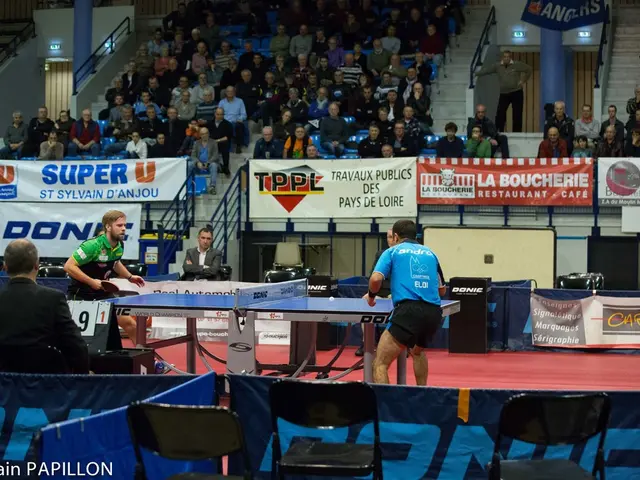Simplifying Blackjack for Novices: Breaking Down the Game into Easy-to-Follow Stages
You're no dummy, but learning a new game like blackjack can be overwhelming. Let's get you feeling like a pro with this simple guide on how to play blackjack, whether you're betting online or in a real casino.
What You'll Learn
- The Basics: Discover the fundamental rules and objectives of blackjack, including its objective and how to win.
- Card Values and Game Mechanics: Learn about card values and the importance of hitting, standing, doubling down, and splitting.
- Strategies for Success: Explore simple strategies that can help you win more often.
- Avoiding Common Mistakes: Identify common pitfalls that beginners often fall for, so you can steer clear of them and improve your game.
- Etiquette at the Table: Understand the dos and don'ts of blackjack etiquette, for a smooth gaming experience.
Understanding Blackjack
The objective of blackjack is to get as close to 21 as possible without going over, and have a higher card value than the dealer. When you sit at a blackjack table, you're playing against the dealer, not the other players.
Card Values and Scoring
Blackjack is played with a standard 52-card deck. The cards are valued as follows:- Ace: 1 or 11- 2-10: Face value- Jack, Queen, King: 10
You calculate your total by adding the values of your initial two cards. For example, 3 + 9 equals 12, while 10 + 8 equals 18. The goal is to have a total of 21, known as a "Blackjack".
The Deal
The dealer will deal out two cards to each player, face up. They'll also get one card face up and one face down. Once all players have played, the dealer will reveal their face down card and deal cards to themselves until their total card value is between 17 and 21 or they Bust (go over 21).

Structure of Play
Learning the rules of blackjack is relatively simple. The goal is to get as close to 21 without going over. After receiving your initial two cards, you have the option to Hit (get another card), Stand (don't get another card), Double Down, or Split (if you have a pair).
When to Hit or Stand
Knowing when to Hit or Stand is key. Generally, you Stand when you have 17 or more, and Hit when you have 16 or less. There are specific situations where these general guidelines might not hold, such as when the dealer shows a low card (2-6).
Doubling Down and Splitting
Doubling Down allows you to double your initial wager in exchange for one more card. This is a strategic move that can boost your winnings, but only if done at the right time. Generally, you should Double Down on a total of 11.
Splitting involves separating a pair into two separate hands. You double your wager, and each hand gets a new card. Splitting pairs of 8s and Aces is usually a good idea.
Effective Strategies
For beginners, it's best to stick to well-known strategies to minimize the house edge and improve your chances of winning. A basic strategy chart can help, as it suggests when to Hit, Stand, Double Down, or Split based on your cards and the dealer's up card.

Bankroll Management
Setting a budget for your bankroll and playing strategically is essential for managing your money. Avoid large bets to prevent losing a significant amount if you have a losing streak. Adjust your strategy based on game progress, but focus on the basic strategy until you're more familiar with the game.
Debunking Myths and Misconceptions
Don't believe these common myths about blackjack:1. Blackjack is purely a game of luck: Strategies and even some card counting can help you make educated guesses about remaining cards.2. You should always take insurance: Insurance is rarely worth it, as it costs more in the long run and has a low probability of paying off.3. The house edge means blackjack is a losing game: With an optimal strategy, the house edge can be as low as 1%, meaning you can still win over time.
Discovering Blackjack Variations
- Classic Blackjack: The standard way blackjack is played in most casinos, both online and offline.
- European Blackjack: The dealer doesn't receive their second card until all players have completed their turns, affecting your Hit or Stand decisions.
- Progressive Blackjack: A portion of each player's wager goes into a progressive jackpot. Winning often requires meeting specific criteria, such as a suited Blackjack or a 5-card 21.
Payout Systems
- Win: A win pays 1:1, meaning if you bet $10 and win, you get $10.
- Blackjack: Most Blackjacks pay 3:2, while some pay 6:5.
- Push: A tie results in no winning or losing of your bet.
Side Bets and Their Odds
Side bets offer variety, but they have lower odds of winning. Popular side bets include Perfect Pairs, 21+3, and Lucky Ladies. Understand the odds and rules before placing side bets.
Casino Etiquette and Good Practices
- Ask questions: If you're unsure about something, ask the dealer for clarification.
- Don't touch the cards: The casino staff may ask you to leave if they catch you touching the cards.
- Mind your chips: You aren't allowed to move your chips after you've placed your bet.
- Be a good winner or loser: Show respect for other players and the dealer, and celebrate or accept losses graciously.
- Leave if needed: If you don't like the table or atmosphere, feel free to leave and find another one.
Resources for Practice and Improvement
- Use cheat sheets and strategy cards: These guides provide optimal decisions based on a combination of your cards and the dealer's up card.
- Free online games: Practice your blackjack skills without risking money by playing free games online.
- Online casinos: Sign up for bonuses and practice with real money while learning the ropes.
Blackjack for (not so) Dummies
Now that you've gone through this guide, you have a better understanding of blackjack and the basics for getting started. Remember to have fun, set limits, and avoid emotions-driven decision-making. Happy gaming!
[1] [https://www.thebalancesmb.com/key-differences-between-blackjack-games-2181482][2] [https://www.wikihow.com/Play-Blackjack][3] [https://www.888casino.com/blackjack/strategy][4] [https://www.bovada.lv/learning-center/blackjack/splitting-pairs][5] [https://www.learnblackjackstrategy.com/blackjack-simulator]
- A beginner's guide to blackjack is essential for understanding the fundamental rules and objectives, along with card values and game mechanics. This knowledge will help you play casino-games like blackjack both online and in real casinos.
- Become proficient in strategies for success, such as thebasic strategy, and avoid common beginners' mistakes to enhance yourblackjack performance.
- Cashback offers at online casinos can provide further incentive for playing blackjack, offering a portion of your losses back as cash.
- The objective of blackjack is to have a higher card value than the dealer without going over 21. A key aspect of the game is knowing when to Hit or Stand, which involves calculating card values and strategizing based on your cards and the dealer's up card.
- Side bets like Perfect Pairs, 21+3, and Lucky Ladies offer additional excitement but come with lower odds of winning. Learn the rules and odds of these side bets before placing them at the casino-and-gambling table.





